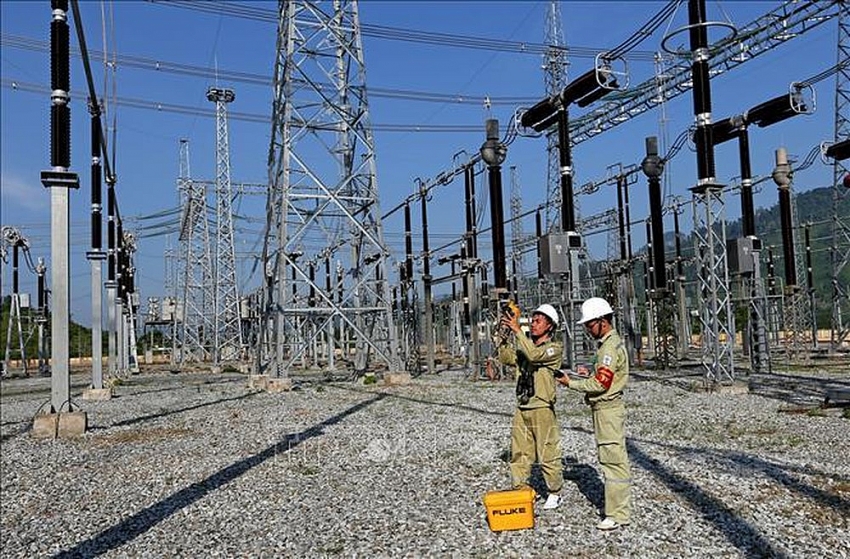Vietnam faces power shortages due to difficulties in capital and land clearance
 |
| Many power projects are falling behind schedule due to various difficulties |
Speaking at the National Assembly Economic Committee’s session on September 7 to review the electricity sector and electricity development measures by 2030 to better meet socioeconomic development requirements, Minister of Industry and Trade Tran Tuan Anh said that the total traditional power sources (thermal power and hydropower) taken into generation in the 2016-2020 period reached only 60 per cent of the initial expectations.
The reason is the difficulty in mobilising investment from private investors and the state to develop power projects. In addition, although the construction of renewable energy projects have been accelerated, the power transmission system has not been developed in step, which forced a number of solar power projects in Ninh Thuan and Binh Thuan run below full capacity. These renewable energy projects may begin operating at full capacity by the end of this year when the power transmission system is completed.
Furthermore, dependence on imported materials is another reason of the power shortages, said the minister. Vietnam has spent around $2.6 billion importing 36.5 million tonnes of coal in the first seven months of this year, up 50 per cent in volume on-year, according to Vietnam Customs.
As for gas, most 2020 targets have been met or exceeded, save for liquefied petroleum gas (LPG) production, where only 50 per cent has been reached. Meanwhile, processing, storage, and distribution providers have only been able to meet 25 per cent of the country’s petrochemical processing demand this year.
The Ministry of Industry and Trade forecast that Vietnam may import 60 million tonnes of coal and 12 million tonnes of liquified natural gas (LNG) in 2030.
The above-mentioned challenges are the consequence of the low construction quality and implementation of the power sector planning strategy, reflected in the unpredictability, lack of synchronisation, and lack of a real monitoring mechanism.
“In addition, localities are not fully compliant with the national power planning, causing uneven development. The development of the power transmission system has faced massive difficulties in terms of land clearance and compensation,” Tuan Anh said.
At present, the construction of numerous thermal power plant projects, including Van Phong I, Vinh Tan III, Nghi Son II, Vung Ang II and Nam Dinh I, is running behind schedule due to delays in negotiating build-operate-transfer (BOT) contract.
In addition, there are 10 major power projects that should have been put into operation during 2016-2020 but are proceeding slowly, including Song Hau 1, Thai Binh 2, Long Phu 1, Na Duong 2, and Cam Pha 3.
Notably, PetroVietnam was the investor of eight of these projects with the total capacity of 11,400MW. Three projects are expected to start full operations in 2016-2020 and the remaining five projects in 2021-2025. However, as of now, all eight projects are facing difficulties in starting start operation on time and two were even handed to other investors.
In addition, the construction of four projects with the total capacity of 2,950MW invested by Vinacomin is also running behind schedule.
What the stars mean:
★ Poor ★ ★ Promising ★★★ Good ★★★★ Very good ★★★★★ Exceptional
Related Contents
Latest News
More News
- PM orders investment model for North–South high-speed rail (December 22, 2025 | 17:43)
- First members of Danang International Finance Centre revealed (December 22, 2025 | 17:39)
- Securing capital and efficiency for Vietnam’s 2026-2030 growth ambitions (December 17, 2025 | 10:00)
- Driving double-digit growth through green and circular transformation in Vietnam (December 17, 2025 | 09:00)
- Vietnam bucking trend in the global M&A landscape (December 16, 2025 | 14:20)
- Vietnam’s green transition demands collective financial action (December 15, 2025 | 12:00)
- VIR workshop highlights capital and policy for sustainable development (December 15, 2025 | 11:00)
- National Assembly approves pilot mechanisms to accelerate major projects in Hanoi (December 12, 2025 | 11:29)
- Vietnam eases policy approval requirements, simplifies foreign and outbound investments (December 11, 2025 | 17:53)
- Unpacking new momentum in Vietnam’s M&A market (December 10, 2025 | 09:59)

 Tag:
Tag:



























 Mobile Version
Mobile Version